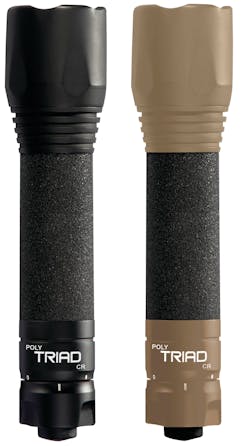Review: ASP Triad DF and Poly AA Flashlights
Two is one; one is none. This is a military axiom that is heard and repeated during any preparation for an operation. Given that 80% of the data we humans use to make decisions comes to us through our eyes, there is no way to overvalue our ability to see; especially in high-risk environments. The need to properly navigate, identify targets and judge conflict circumstances is paramount and the lights we use to assist us cannot fail. Since virtually everything mechanical or electrical (or both) DOES fail at some point, the best method of preparation is having a redundant unit. Hence, “two is one; one is none.” With that understood, let's take a look at two flashlights from Armament Systems and Procedures, better known as ASP, the Triad DF and Poly AA.
Gone are the days when having a decent light output meant having six C- or D-cell batteries and all the size / weight that went with them. Now you can get a good amount of light from a much smaller flashlight. How much light depends on the power source and the bulb used. For durability’s sake, LEDs have become the most common type of bulb or lamp assembly. Those who have abused their flashlight(s) know that LED lamp modules are far harder to break than incandescent bulbs and, with the development of LED technology across the span of the past 15 years, can put out equivalent or brighter light. The light is certainly “cleaner” – more white, less yellow.
There are pros and cons to differing types of power for these LED lamp assemblies and we’ll discuss those mixed in as we look at the two lights to be discussed. Both the Triad DF and the Triad AA are driven by LED lamp assemblies.
The Triad DF
The Triad DF (which stands for Dual Fuel) is powered by your choice of either a rechargeable battery until OR two CR123A 3V lithium batteries. The rechargeable battery isn’t difficult to recharge when it gets low on juice; you simply use the provided USB cord to plug it into an appropriate outlet and use the micro-USB connection on the side of the light to plug it in. NOTE: If you are using the CR123A 3V lithium batteries, they are NOT rechargeable and you should not attempt to do so. Even with that warning considered, ASP’s circuit design ensures safety by preventing such an attempt to recharge non-rechargeable batteries.
Using either the rechargeable battery unit OR the two CR123A 3v lithium batteries, the Triad DF reportedly produces 400 lumens of light for a run time of 3 hours. The strength of either battery unit is the amount of power supplied to the lamp module. Lithium batteries typically provide a greater level of power and permit higher light outputs for reasonable usage times. Additionally, the use of the rechargeable unit minimizes battery cost over the life of the flashlight. With an overall length of 6.25”, a maximum diameter of 1.4” and weighing well under half a pound (less than 7 ounces), this is a powerful yet compact light that is easy and convenient to carry. But… what do you carry as a backup? Remember: two is one and one is none.
The Poly AA
The Poly AA is a different material, different power source and different overall performance. Using two AA batteries instead of the rechargeable unit OR 3V lithium batteries, the Poly AA produces 275 lumens as compared to the 400 of the Triad DF. That difference in light production is why this light is listed as the “backup” light. Additionally, the length of run time is reduced to 1.75 hours according to the published material. Reduced light production and reduced run time combine to qualify this as a good backup light but not preferred as your primary flashlight.
The strength of the light is two-fold:
- First, AA batteries are far less costly than 3V lithium batteries, and
- Second, weighing only 5 ounces, it’s even lighter in weight than the Triad DF.
Overall length is 7.125” and the overall diameter is the same. The extra length of the Poly AA is due to the dimensions of the batteries contained. Either light will serve you well, but having them combined as primary and backup light ensures you almost five hours of useful light in reasonably compact packages.

Lt. Frank Borelli (ret), Editorial Director | Editorial Director
Lt. Frank Borelli is the Editorial Director for the Officer Media Group. Frank brings 20+ years of writing and editing experience in addition to 40 years of law enforcement operations, administration and training experience to the team.
Frank has had numerous books published which are available on Amazon.com, BarnesAndNoble.com, and other major retail outlets.
If you have any comments or questions, you can contact him via email at [email protected].



